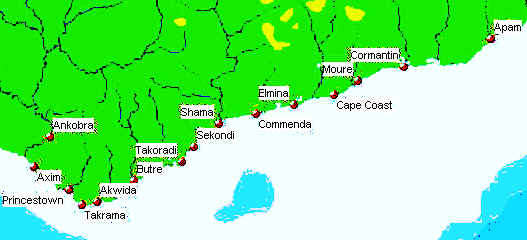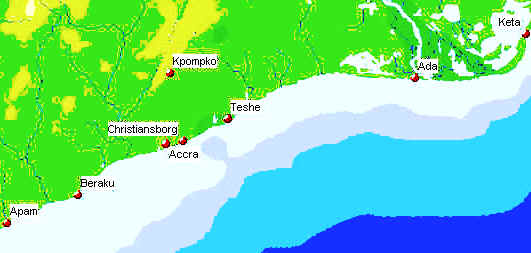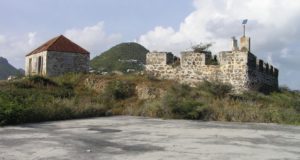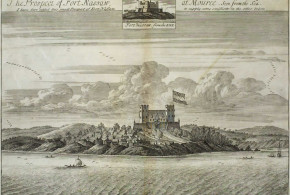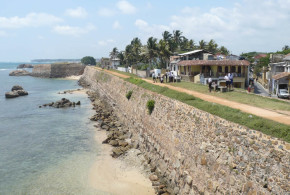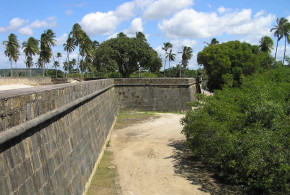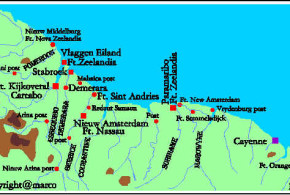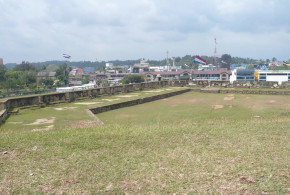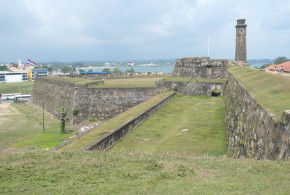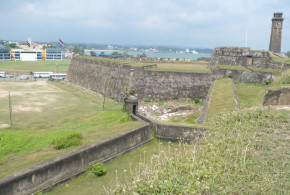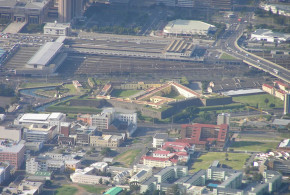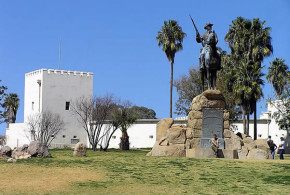Written by Marco Ramerini. English text revision by Dietrich Köster.
FORT SÃO JORGE DA MINA (ELMINA)
The first European-built fort in Ghana was Fort São Jorge da Mina (Elmina), which was built by the Portuguese in 1482 near an African village, with which they traded, called by them Aldeia das Duas Partes. The foundation stone of this castle was laid on 21 January 1482 under the supervision of the Portuguese Captain Diogo de Azambuja, who was at the head of an expedition of 600 Portuguese.
This fort was the Headquarters of the Portuguese on the Gold Coast from its foundations to the Dutch conquest in 1637. The government of this castle was esteemed to be, at the beginning of XVIth century, one of the most important positions in the Portuguese empire. During the Portuguese time the garrison of the fortress consisted of a Governor with his staff of ten people, a factor or feitor with a staff of four men, two clerks, an apothecary, a surgeon, a smith, a cooper, an overseer of provisions, some stonemasons, some carpenters, two or four priests and about 20-60 soldiers.
In 1486 São Jorge was granted the City status, and a wall was built around the African settlement. From the first trading contacts the villagers of Aldeia das Duas Partes developed a kind of Portuguese Creole, which made the relationship between the Africans and the Portuguese easier. This language continued to be used till the XVIIIth century. In the first years of the XVIth century also the conversions of Black people began. In 1503 on the slopes of a hill near the castle was built a small chapel dedicated to Santiago. This chapel was used till 1596, when the building was dismantled.
Elmina Castle was very important for trade purposes. The trade goods of Mina were gold, ivory, sugar, wax, pepper, hides, slaves. Since the beginning of the Portuguese installation at São Jorge they established business relations with the adjoining African states (Akan, Wassaw, Commany, Efutu) to increase the trade. The Portuguese power on the Gold Coast never went beyond the coast-line. They built in 1503 the fort of Santo António de Axim, maintaining intermittently a trading post at Shama and in 1576 a short-lived fortress at Accra.
In 1596 during the government of captain Cristóvão de Melo (1596-1607) a Dutch expedition – equipped by the Dutch commercial trading house of Moucheron – attacked the castle for the first time. The attempt ended in a failure. On 7 September 1606 the Dutch made a second attempt to capture São Jorge; about 600 Dutch soldiers disembarked at Moure and later they marched against São Jorge. The Portuguese governor Dom Cristovão de Melo made a successful ambush with his troops and after two hours of fighting the Dutch were in retreat; in the meanwhile a small Dutch detachment had been sent towards Axim. Here after a fighting the Dutch beat the retreat, too. The Dutch made repeated assaults on São Jorge in December 1606 and January 1607, but finally in January 1607 they gave up. In 1615 a violent earthquake damaged the fortress walls and a bastion collapsed.
The Dutch – after having got knowledge of this – made three unsuccessful attacks against Elmina. In 1625 under the command of the Dutch Admiral Jan Dirickszon Lam a big Dutch squadron of 15 ships, 1.200 Dutch soldiers and 150 African allies anchored near Elmina with the aim to subdue the Portuguese fort. The fort was garrisoned by only 56 men under the Portuguese governor Dom Francisco Sotomaior and were assisted by a number of African allies.
On 25 October 1625 the Dutch opened the battle bombarding the castle. Later the Dutch began to march to São Jorge. The African warriors – allies of the Portuguese – ambushed the Dutch. They were taken by surprise. Confused by the unexpected assault, they beat the retreat leaving on the battle-field about 500 men. Thanks to their African allies this was a great victory for Portugal. In August 1637 a new Dutch squadron of 9 ships and 800 men anchored near Cabo Corso (Cape Coast), where they were joined by some 1.200 African allies. On 26 August 1637 the Dutch landed and – divided in three columns – marched towards the fortress. The first Dutch move in the attack of 1637 was the seizure of the unfortified hill of Santiago, from where they shelled São Jorge castle. By this strategic move the Portuguese were forced to surrender after a few days. The Dutch conquered Elmina on 29 August 1637. A Dutch garrison of 175 men was left in the castle. After more than 150 years a new European power – the Netherlands – ruled on the Gold Coast.
After the conquest the Dutch fortified the hill of Santiago with an earth-work. Later the fort on the hill – called Fort Conradsburg – was improved and enlarged and was completed by 1666. In 1645 the Dutch personnel at Elmina and Conradsburg consisted of 83 men and there were also 184 slaves working in the castle. The fort was in Dutch hands till 1872, when it was sold to the British. Very little of the early Portuguese castle is now visible. The only portion, which has remained intact, is the cistern that dates from 1482. The lay-out of today’s castle is the same, more or less, of the Dutch conquest in 1637. Outside the fort is still well preserved the Dutch Reformed church built at the end of the Dutch rule.
FORT SÃO SEBASTIÃO (SHAMA)
In the early years of Portuguese trading activity on the Gold Coast the first center, which was frequented by them, was the village of Shama, east of Cape Three Points. Here they maintained a small lodge for several years. In 1558 a wooden palisade and a tower were built and a permanent garrison was established. During the early 1600s the garrison of this station was formed by only one official and in 1637 the Dutch, when they occupied it, found this fort abandoned. They garrisoned it with a commander, 4 soldiers and 15 slaves (1645). In 1664 the fort was captured by the English, but a year later the Dutch regained possession of it and rebuilt it. Near the fort they maintained a cotton plantation from 1765 till 1783. This fort was in their hands till 1872, when it was ceded to the British.
FORT SANTO ANTÓNIO DE AXIM (AXIM)
In August 1503 a small trading-post was built by the Portuguese to the west of Cape Three Points. It was called Fort Santo António de Axim and in 1515 this fort was reinforced. The fort was an important trade center during the Portuguese rule. It was garrisoned by 10-20 Portuguese soldiers only, and they were – if necessary – assisted by a force of 150 African allies. After the Dutch capture of São Jorge Axim it remained in Portuguese hands for a few more years. A first Dutch attack was driven back in 1641, but in February 1642 a new attempt was successful and the Dutch occupied the fort. In 1664 the English captured the fort, but the Dutch soon retook it. It was in Dutch hands till 1872, when it was sold to the British.
ACCRA
In 1557 the Portuguese built a small fortified lodge in Accra. In 1576 they decided to enlarge the lodge and to build a strong fort, but in 1577/78 Africans attacked the half-built fort and destroyed it.
FORT NASSAU (MOREE)
Between 1595 and 1600 merchants from the Netherlands founded a small unfortified lodge at Moree for trade in gold. In 1610 the Portuguese made an attack against the Dutch trading station at Moree. They burnt the African village adjoining the lodge. In reaction to this attack the Dutch built their first fort on the Gold Coast in 1612: Fort Nassau. This fort was originally a small earthwork and wooden fort and was built on a hill overlooking the sea at Moree. It was rebuilt and enlarged in 1623-24 and in 1633-34. In 1615 a new Portuguese raid was successful and the African town was newly burnt. Moree was the Dutch headquarters till the conquest of Elmina in 1637. In 1645 the Dutch garrison was composed of 32 men including the commander. There were then a surgeon, a preacher, a coppersmith and 156 slaves working in the castle. Moree was occupied by the British in 1664 and recaptured by the Dutch in 1665. In 1782 it was again in British hands, but the Dutch regained it by treaty in 1785. In the first decades of the 19th century it was abandoned. The remains of this fort are nowadays only very few.
FORT CHRISTIANSBORG (ACCRA)
In 1652 the Swedes built a lodge in Accra and in 1660 it was seized by the Dutch. In 1661 the Danes occupied the place and built a fort named Fort Christiansborg. This fort was situated near two other forts: Fort Crèvecœur and Fort James, the former Dutch and the latter English. The Danish fort was located on a rock cliff near the African town of Osu and its position was the best of the three. The fort was in Danish hands for nearly two hundred years except for a short Portuguese occupation. On 2 December 1680 a Portuguese ship arrived at the Danish fort. The Danish Governor Bolt sold the fort to the Portuguese commander of the ship Julião de Campos Barreto. The Portuguese renamed it Fort São Francisco Xavier and built a chapel in the fort. The Portuguese abandoned the fort on 29 August 1682. It was then occupied by the Akwamu tribe until February 1683, when the Danes from nearby Fort Fredriksborg reoccupied it. In 1685 the Danes moved their headquarters from Fort Fredriksborg to Fort Christiansborg. The fort was square shaped with four bastions. In 1693 an African tribe occupied the fort, but in 1694 the Danes retook it. The Danes made several attempts to establish plantations near the fort and they also established in the early 1800s a hill-station and a plantation thirty–two kilometers inland from Fort Christiansborg at Kpomkpo (Frederiksborg). In 1850 the Danes sold the Castle to the British.
FORT GROSS-FRIEDRICHSBURG (PRINCESTOWN)
Brandenburg was a historic Electorate (Kurfürstentum) which formed the primary nucleus of the Prussian State. Under the reign of the Grand Elector Friedrich-Wilhelm von Brandenburg, was created an African Company, this company for about forty years ruled on several African forts at: Arguin, Takrama, Takoradi, Akwida (Ft. Dorothea), Whydah and Princestown or Poquefoe (Gross-Friedrichsburg). On New Year’s Day 1683 a Brandenburg expedition of two ships arrived on the Gold Coast and started to build a strong fort between Axim and Cape of Three Points, which was named Gross-Friedrichsburg. The fort was to be the headquarters of Brandenburg in Africa, it was garrisoned at the beginning by 91 European men and 130 Africans. The fort was a square shaped with four bastions. In the first 15 years the Brandenburgers developed well the trade with the Africans, but from 1700 trade began to decline. The Company was an ally of the African chief John Couny who was waging a war against the Dutch and the English. In 1720 a treaty was concluded between the King of Prussia and the Dutch, and all the African forts of Brandenburg were sold to the Hollanders, but the African ally of Prussia/Brandenburg, John Couny, refused to surrender Gross-Friedrichsburg. In 1725 the Dutch captured Fort Gross-Friedrichsburg and renamed it Fort Hollandia. The fort was abandoned by the Dutch in 1815.
FORT AMSTERDAM (CORMANTINE)
In 1631 the English had a lodge in Cormantine. In 1645 they built a fort on the summit of a hill. In 1665 the Dutch occupied it during a struggle and renamed it Fort Amsterdam. In 1782 the Dutch surrendered the fort to the British, but in 1785 it was newly in Dutch hands by a treaty. In 1811 the African tribe of Anomabu captured the fort, which was later abandoned.
BIBLIOGRAPHY ON THE EUROPEANS FORTS IN GHANA
– Bato’ora Ballong -Wen-Mewuda, J. “São Jorge da Mina 1482-1637” 2 voll. 642 pp. Fondation Calouste Gulbenkian-C.N.p.l.C.d.D.P. 1993 Lisboa-Paris Complete study on Elmina castle during the Portuguese period.
– Cardinall, Allan Wolsey “A Bibliography of the Gold Coast” Martino Publishing & Wayfarer’s Bookshop, Mansfield Centre, 2002, CT
– Decorse, Christopher “An Archaeology of Elmina : Africans and Europeans on the Gold Coast, 1400-1900” Smithsonian Institution Press, 2001
– Ephson, I. S. “Ancient forts and castles of the Gold Coast (Ghana)” 112 pp. 18 ills. Ilen Publications 1970 Accra, Ghana Index: The origins; location of the forts and castles; number of forts and castles; the tenants; unhappy incident; gallant governors; problems of the forts and castles; no more forts and castles; cui bono; the surviving settlements.
– Feinberg, Harvey M “Africans & Europeans in West Africa: Elminans & Dutchmen on the Gold Coast during the Eighteenth Century” 189 pp. Diane Publishing Co., 1989 The town of Elmina was the most important trading center on the Gold Coast (GC) of W. Africa for at least 2 cent. Elminans engaged in commercial transactions which linked the GC with 3 very different trade networks. Contents: (I) The Akan on the GC; (II) Europeans on the GC: The Portuguese, 1471-1642; & The Dutch from 1593; (III) Akan Participation in the Atlantic Trading System; (IV) An Intro. to Elmina; (V) The Elmina Political Framework; (VI) The Functioning of Govt.: Justice & Dispute Settlement; & Foreign Affairs; & (VII) Elmina-Dutch Relations. Appendices: Elmina Chronology; Weights, Measures & Def.; Dirs. Gen. & Pres. of the 2nd W. India Co.; Counts of Indictment & Defense of the Negroes of Mina; & Elmina Leaders. Biblio. Illustrations.
– Giordano, Rosario “Religione e politica nel confronto tra missionari cattolici e brasiliani a Ouidah, 1861-1871” In: “Africa” LIII, 2, 1998, pp. 239-257
Iria, Alberto “Da fundação e governo do Castelo ou Fortaleza de São Jorge da Mina pelos Portugueses e da sua acção missionaria após o descobrimento desta costa” In STUDIA N° 1, pp. 26-69, 1958, Lisboa, Portugal.
– Kessel, Ineke van “Merchants, Missionaries and Migrants: 300 Years of Dutch-Ghanaian Relations” Kit Publishers, In November 1701, David van Nyendael, an envoy of the Dutch West India Company (WIe was the first European to visit the royal court in Kumasi, capital of the emerging Ashanti empire in the hinterland of the Gold Coast. Three hundred years of Dutch-Ghanaian relations have passed since then. “Merchants, Missionaries and Migrants” focuses on various aspects of this long-standing and intricate economic, political and cultural relationship between the Ghanaians and the Dutch. Experts from Ghana, the Netherlands, Suriname and Indonesia present their research findings in fascinating histories. They describe a wide range of topics from Dutch-Ghanaian history: from the trade in gold, ivory and slaves to the cocoa trade; from liaisons between European men and African women in previous centuries to present-day Ghanaian migration to the Netherlands; from the involuntary migration of tens of thousands of slaves to the plantations in Suriname to the largely forgotten history of the African soldiers who sailed from Elmina to serve in the Dutch army in the East Indies; and from the role of Dutch geneva in Ghanaian ritual to the tragic story of Jacobus Capitein, the first black Christian minister to be ordained in the Netherlands.
– Lawrence, A. W. “Trade Castles and Forts of West Africa” 390 pp. 48 maps & 158 plates Jonathan Cape 1963 London, U.K. A detailed description of about 40 Europeans forts and castles from Arguin (Mauritania) to Whydah or Ouidah (Benin). Many illustrations and maps of the forts. Chronological history of the forts. Index: The place of the fortsystem in history; the setting of times; organization and personnel; life at the forts; relations between fort and town; types of building; materials and structure; early draughtsmen; Elmina castle: the Portuguese and later Dutch headquarters; other headquarters: Cape Coast Castle, Christiansborg, Princestown; early forts: Axim, Mouri, Cormantin, Gambia, Butre, Shama; forts about 1700: Akwida, Commenda, Dixcove, Apam, Sekondi, Beraku; forts of the late eighteenth century: Anomabu, Beyin, Keta.
– Pezzoli, G. & Brena, D. “Forti e castelli di tratta” 50 pp. Centro Studi Archeologia Africana, 1990, Milano. A collection of several plates of European castles in Africa.
– Van Dantzig, A. “Forts and castles of Ghana” Sedco, 1980, Accra, Ghana. – Van Dantzig, A. and Priddy, B. “A short history of the forts and castles of Ghana” 59 pp. map and ills. Liberty Press, 1971, Accra, Ghana. Index: The Portuguese period, Dutch penetration and the expulsion of the Portuguese, English Swedish and Danish penetration, growth of the English trade, the Brandenburg Company, the 18th. century, the 19th century.
– Vasconcelos, Frazão de “A Fortaleza de São Jorge da Mina” 14 pp., [2] pp. Mundo Português, 1934, Lisboa, Portugal.
– Vogt, J. “Portuguese rule on the Gold Coast 1469 – 1682” 266 pp. 2 maps University of Georgia Press 1979 Athens, Georgia, USA Complete study on the Gold Coast during the Portuguese period.
 Colonial Voyage The website dedicated to the Colonial History
Colonial Voyage The website dedicated to the Colonial History
